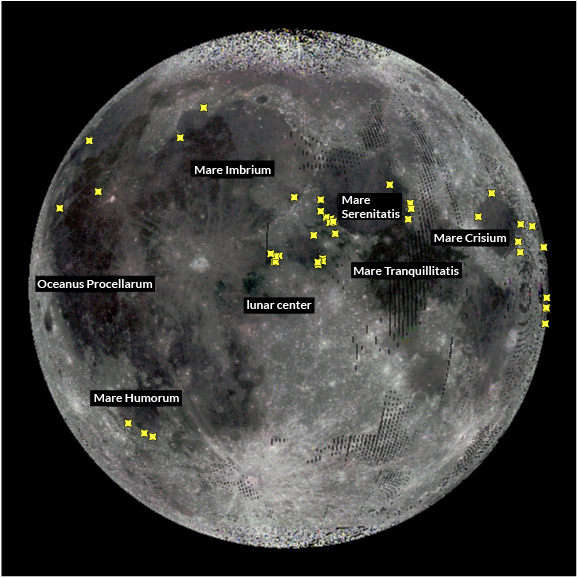—Mapping of lunar resources and minerals using hyperspectral remote sensing technology—
Researchers) YAMAMOTO Satoru, Group Leader, MATSUOKA Moe, Researcher, IKEDA Ayame, Researcher, Research Institute of Geology and Geoinformation
- Data mining techniques using lunar exploration data to identify areas of concentrations of ilmenite on the Moon's surface
- Ilmenite-rich materials are widely distributed in lunar pyroclastic deposits.
- Reserves are estimated to be more than 100 billion tons and are attracting attention as a resource mineral that can be procured on the moon.

Distribution map of ilmenite-rich areas on the Moon (marked in yellow)
The background is a lunar brightness map (produced using multi-band data from the lunar explorer KAGUYA (SELENE)). The dark region in the figure is a region called "mare" covered with basalt, corresponding to the so-called "Moon rabbit” in Japan.
*Data published in the KAGUYA (SELENE) Data Archive (https://darts.isas.jaxa.jp/app/pdap/selene/index.html.ja) (ISAS/JAXA) are processed and used.
Researchers of AIST, Ritsumeikan University and University of Aizu have successfully identified areas of concentrations of ilmenite on the Moon's surface by data mining analysis using hyperspectral data acquired by the lunar exploration satellite KAGUYA (SELENE), and succeeded in identifying the highest concentrated areas of ilmenite. Detailed analysis of the identified concentrated areas using a high-spatial resolution terrain camera and a multi-band imager that can observe in multiple wavelengths of electromagnetic waves revealed that ilmenite is widely distributed in lunar pyroclastic deposits. Water, oxygen, iron, and titanium extracted from ilmenite (FeTiO3) are essential resources for human base construction and manned activities on the Moon. The results of this research are expected to contribute to the design plan for a sustainable resource extraction base on the Moon and to stimulate a new space industry market through the development of technologies for oxygen supply and manufacturing of lightweight materials on the Moon.
Details of the results were published in the Journal of Geophysical Research-Planets on March 10, 2025.
In recent years, efforts to explore the Moon for industrial applications and resources have been accelerated. As various private companies have begun to develop technologies for water and oxygen extraction on the Moon and for the design and manufacture of lunar bases and transportation equipment, the importance of securing resources that can be procured on the Moon is increasing. Ilmenite is one of the titanium oxide minerals found in lunar basalt. Since basalt is formed when magma generated in the interior of the Moon erupts onto the surface, a detailed study of ilmenite in basalt will lead to an understanding of the interior composition and evolution of the Moon. Furthermore, it is known that ilmenite can be utilized to obtain water, oxygen, iron, and titanium, which are considered to be important resources essential for manned activities such as lunar base construction. Therefore, clarifying the distribution of ilmenite on the Moon is important from the perspective of both lunar science and resource exploration. On the other hand, ilmenite appears "darker" than its surroundings because it is less reflective than the major minerals on the Moon, making their detection and discrimination by remote sensing difficult. Therefore, there has been insufficient knowledge of the geology of ilmenite-rich areas, such as the distribution and stratigraphy of concentrated areas of ilmenite on the lunar surface, and basic information that can be used as a strategy for resource extraction has not been developed.
Journal: JOURNAL OF GEOPHYSICAL RESEARCH-PLANETS
Title of paper: Global distribution and geological features of ilmenite-rich sites on the lunar surface
Authors: Satoru Yamamoto, Moe Matsuoka, Hiroshi Nagaoka, Makiko Ohtake, and Ayame Ikeda
DOI: 10.1029/2024JE008663